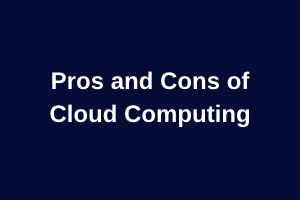Introduction:
Cloud computing has emerged as a revolutionary technology, transforming the way businesses operate and store their data. This paper aims to explore the advantages of cloud computing and provide insights into effective implementation strategies that can help organizations harness its benefits. By understanding the potential of cloud computing and adopting appropriate strategies, businesses can streamline their operations, enhance flexibility, and achieve cost efficiencies.
Advantages of Cloud Computing:
- Scalability and Elasticity: Cloud computing enables businesses to scale their resources up or down based on demand, allowing for efficient resource utilization and cost optimization.
- Cost Savings: By eliminating the need for on-premises infrastructure and shifting to pay-as-you-go models, businesses can significantly reduce capital expenditure and IT maintenance costs.
- Flexibility and Mobility: Cloud computing offers the flexibility to access data and applications from anywhere, enabling remote work, collaboration, and improved productivity.
- Data Security and Reliability: Cloud service providers invest heavily in robust security measures, ensuring data protection and reliable backups, reducing the risk of data loss.
Cloud Computing Implementation Strategies:
- Cloud Migration: Organizations need to develop a well-defined migration strategy to smoothly transition their applications and data to the cloud. This involves assessing workloads, selecting appropriate cloud models (public, private, or hybrid), and ensuring compatibility and data integrity during the migration process.
- Cloud Service Selection: Depending on specific business requirements, organizations should carefully evaluate different cloud service providers, considering factors such as reliability, scalability, security, compliance, and cost-effectiveness.
- Data Management and Governance: Establishing clear data management policies and governance frameworks is crucial for effective cloud computing implementation. This involves defining data ownership, access controls, data encryption, and compliance with data protection regulations.
- Hybrid Cloud Adoption: Many organizations opt for a hybrid cloud approach, integrating public and private cloud environments. This allows them to leverage the benefits of both, maintaining sensitive data on a private cloud while utilizing the scalability and cost-efficiency of public cloud services.
Disadvantages of Cloud Computing:
- Internet Connectivity Dependency: Cloud computing heavily relies on internet connectivity. Poor internet connection or network outages can disrupt access to cloud services, impacting business operations and productivity.
- Data Security Concerns: Storing sensitive data in the cloud raises concerns about data security and privacy. Unauthorized access, data breaches, or vulnerabilities in the cloud infrastructure can pose risks. Robust security measures and careful selection of trusted cloud service providers are essential to address these concerns.
- Limited Control and Customization: Cloud services may limit organizations’ control over the underlying infrastructure and software. Customization options may be restricted, making it challenging to tailor services to specific requirements. Organizations may need to rely on service provider updates and configurations, affecting their adaptability.
- Compliance and Legal Issues: Storing sensitive or regulated data in the cloud can present compliance and legal challenges. Organizations must understand and comply with relevant data protection regulations and contractual obligations to avoid legal complications.
- Service Reliability and Downtime: While cloud service providers aim for reliability, occasional disruptions or downtime can occur. Temporary unavailability of critical applications and data can impact business continuity and user experience.
- Cost Considerations: Cloud computing offers potential cost savings, but long-term costs should be carefully evaluated. Cloud service costs can accumulate as usage increases, requiring effective monitoring and management of resource utilization to control expenses.
- Vendor Lock-In: Adopting a specific cloud service provider and integrating systems and data can create dependency and make switching providers challenging. This limits flexibility and negotiating power.
Conclusion:
Cloud computing presents advantages and disadvantages that organizations must consider. Cloud computing offers tremendous opportunities for businesses to enhance their operations, improve agility, and drive innovation. By understanding and addressing the potential challenges, organizations can unlock its potential and gain a competitive edge in today’s dynamic business landscape. Successful cloud adoption requires careful planning, resource evaluation, and attention to data security and governance. With the right approach, businesses can embrace cloud computing to propel their growth and success.
If you have skills in PHP programming and you want to enhance your career in this field, a PHP certification from StudySection can help you reach your desired goals. Both beginner level and expert level PHP Certification Exams are offered by StudySection along with other programming certification exams.




